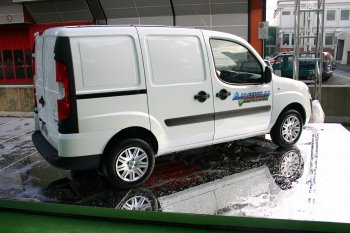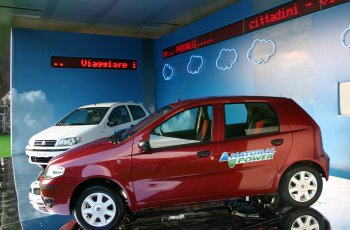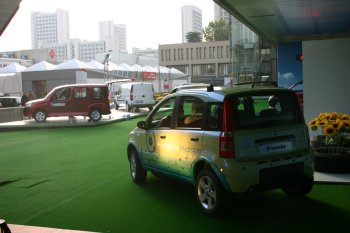|
Minimum
environmental impact Fiat vehicles bearing the 'Natural Power' logo
are on show in Bologna in an outdoor display titled "Flower
Power". Here visitors can see the Punto,
Multipla and Doblò as well as the Punto Van, Doblò Cargo and
Ducato commercial vehicles, all with methane and petrol dual
fuel systems while the Doblò
‘Natural Power’ can be tried out on a dedicated track. Environmental
protection is one of the main guiding strands for the
development of future models as far as Fiat Auto is
concerned.
For this
reason, visitors to the 30th Bologna Motor Show can also see a Panda
Hydrogen, the first Fuel Cell vehicle developed by the Fiat
Research Centre, which offers standards of performance and
roominess comparable to those of conventional cars. The
attention of the major car manufacturers in this field is
now mainly directed toward Fuel Cells known as PEMs (Proton
Exchange Membranes) that can generate electricity through a
process involving the chemical recombination of hydrogen and
oxygen. This type of Fuel Cell offers a quick response to
the car’s energy needs, high specific power and a relatively
simple construction that makes it particularly suitable for
creating light, sturdy and reliable generators to be used
for the generation of electric power on board the car.
More specifically, the Fiat Panda
Hydrogen features ‘Full Power’ architecture. The Nuvera
production stack (i.e. the heart of the Fuel Cell electrical
generation system) is connected directly to the electrical
traction engine and supplies the vehicle with all the power
required. The stack is located beneath the floorpan and
consists of several cells connected in series. Inside,
hydrogen and oxygen atoms combine with the aid of a
catalytic converter to produce water and heat and also
generate electrical energy with zero emissions.
|

 |
|
|
|
 |
|
|
|
The system is supplied with
hydrogen at a pressure of 1.5 bars and produces, from oxygen
contained in air (also compressed), electrical energy with a
maximum power of 60 kW with a high rate of efficiency (60%
at 20% of maximum power). The alternating current
three-phase asynchronous electric motor and the transmission
are located in the engine compartment together with their
accessories.
The hydrogen that feeds the
Fuel Cell is contained at a pressure of 350 bar in a tank
made out of composite material installed beneath the car’s
rear floorpan: all the distinguishing features of the New
Panda passenger compartment are therefore maintained,
including outstanding roominess for four people. The system is complemented by
auxiliary circuits to supply the hydrogen, manage the air
and water and cool the stack. At full power, the Fuel Cell
engine on the Panda Hydrogen delivers 60 kW that allows the
car to reach a top speed of more than 130 km/h, with
acceleration from 0 to 50 km/h in 7 seconds. The car can
also climb a maximum gradient of 23% at take-off. With its
overall capacity of 68 litres, the hydrogen tank assures the
Fiat Panda Hydrogen a range of more than 200 km over an urban
cycle. Refuelling time is very quick also at less than 5 minutes,
i.e. comparable to the time taken to refuel a methane car.
The introduction of the Panda
Hydrogen is simply the latest in a string of developments
that have seen Fiat taking centre stage internationally.
Though Fuel Cell propulsion systems will not be widely
available before the end of the next decade, Fiat Auto has
already been active in their development and application for
a few years – as we saw in 2001 with the debut of the
Seicento ‘Elettra H2 Fuel Cell’, and then the
Seicento Hydrogen. The Panda Hydrogen has now taken up the
baton to take research from the laboratory prototype stage
to that of a field research vehicle. 2006 will see the
beginning of the demonstration stage of small Panda Hydrogen
fleets, as a forerunner to wide-ranging demonstration
programmes promoted and supported by the European Union and
by the Italian Ministries and Regions. The ultimate aim is
for such vehicles to be marketed in 2020.
|
|
|
|
![]()
![]()